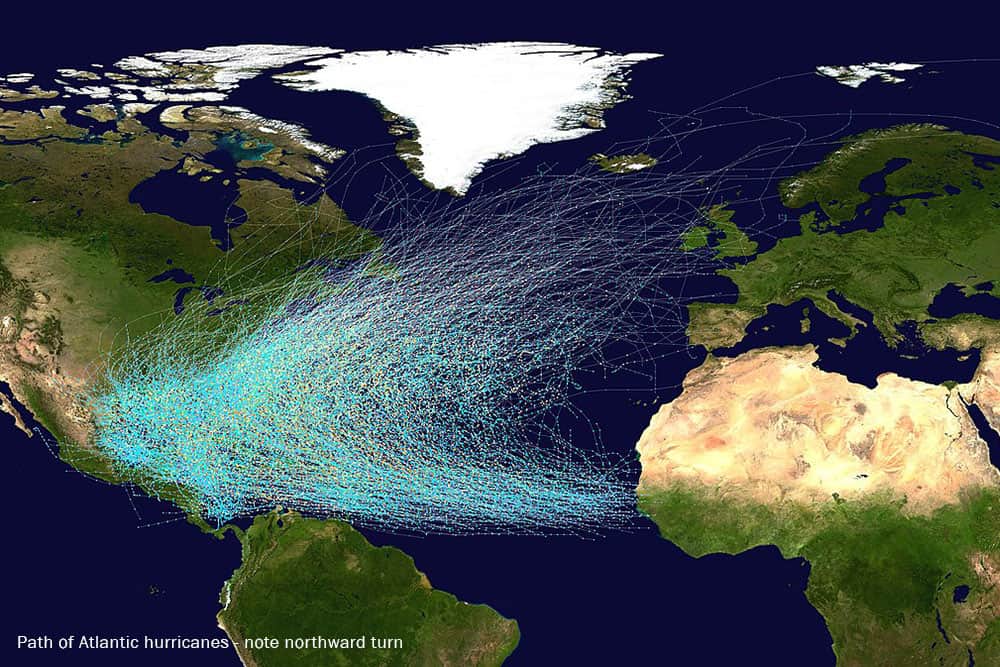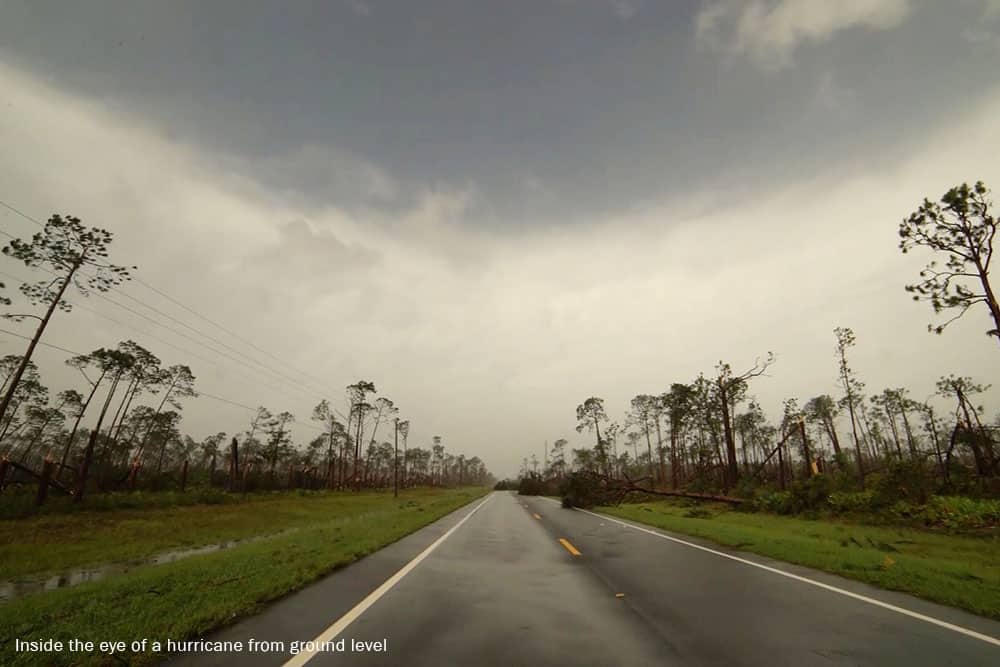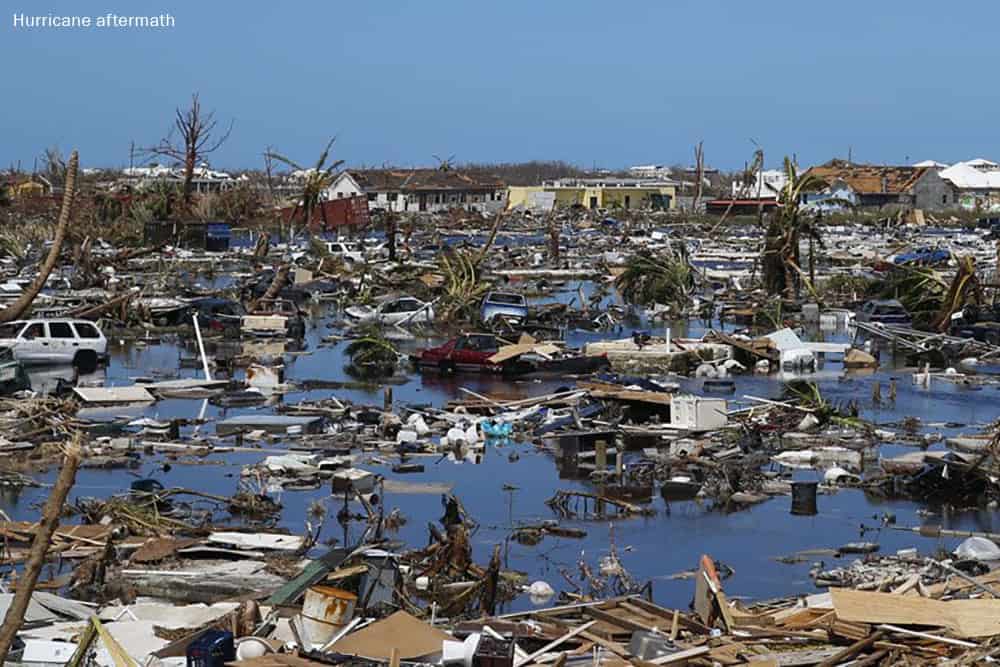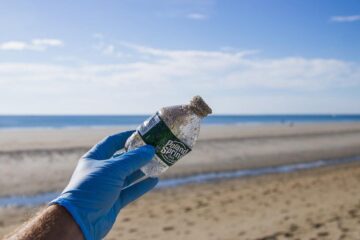An F4 tornado is a devastating natural phenomenon whose winds top 160 mph. It’s capable of reducing a house to a pile of splintered wood in the few seconds it takes to pass over.
Now imagine an F4 tornado that lasts, not for a few seconds, but for hours and you have some idea what it was like to live through Hurricane Camille (1) in 1969 or Hurricane Andrew (2) in 1992 or Hurricane Michael (3) in 2018.
Andrew not only produced wind gusts of nearly 200 mph in some spots and wiped entire neighborhoods in Florida off the map, but as it made landfall again in Louisiana it spawned 61 tornadoes as it moved inland. There have been other hurricanes that spawned even more (4).
But devastating winds are not the only threat from hurricanes. In August 2017 Hurricane Harvey (5) came ashore in Texas and promptly deposited more than 40 inches of rain in the Houston area and more than 60 inches in Nederland, TX.
Catastrophic flooding followed, more than 100 people lost their lives, power was out for weeks in some locations, while property damage was estimated at $125 billion. The Texas Department of Public Safety reported that 185,000 homes were damaged and 9,000 completely destroyed.
So while it’s understandable that some would dismiss the hysterical, end of the world reporting that typically accompanies any tropical storm, you do so at your own risk. Because even if 4 out of 5 hurricanes turn out to be little more than a windy day at the shore, the 5th could send your community back to the stone age.
Below we’re going to look at how to survive a hurricane and divide our tips into 3 parts: before, during and after the storm. But first, a bit of background.
What is a Hurricane?
A hurricane is an intense, highly organized storm that gathers strength as it moves across warm ocean waters. Hurricanes – also called typhoons and tropical cyclones – are the strongest storms on earth and happen almost exclusively in the northern hemisphere. (Although on rare occasions cyclones will form in the South Pacific or the Southern Indian Ocean.)
Atlantic hurricanes typically begin as what are called tropical waves (6) off the west coast of Africa. From there they move out into the Atlantic Ocean where they either dissipate or pick up energy from the warm water and grow into a tropical storm. It is difficult to predict which tropical waves will eventually become hurricanes, but on average about 10% do.
As the hurricane moves west across the Atlantic it eventually encounters the North American land mass. North America has its own weather patterns that blow west to east. When the westward moving hurricane encounters the eastward moving weather patterns of North America it usually turns northward. Sometimes the northward turn happens along the eastern seaboard of the US. Other times the northward turn doesn’t occur until the storm is well into the Gulf of Mexico.
The intensity of a hurricane is measured on the Saffir-Simpson wind scale that ranges from Category 1 to Category 5. Category 1 indicates sustained winds of more than 75 mph. While Category 5 indicates sustained winds or more than 157 mph. Below is animation that demonstrates the different categories and the type of damage that can be expected from each.
Today, however, we have extensive networks of global weather satellites that track every minute of a storm from the time it emerges as a tropical wave off the African coast. Still, many people dismiss hurricane warnings, but they shouldn’t. The threat posed by these monstrous storms is as it gets real. That said, it’s time to take a close look at how to survive a hurricane.
How to Survive a Hurricane: Before
If you are to survive a direct hit from a substantial hurricane preparation is critical. If your home is badly damaged, roads washed out, power lines down and someone is injured you’ll need adequate food, first aids supplies and emergency equipment on hand to deal with those and other potential scenarios.
Waiting until the day before the hurricane makes landfall to prepare is not a strategy that’s going to work. You will have to gather the things things you need well ahead of time and keep them in a ready state. You will also need to finalize the logistics of what to do in case the storm forces you out of your home or loved ones get separated somehow. So where to start? The first thing to do is gather those emergency supplies. Here’s what you should have.
Hurricane Emergency Stockpile
A week’s worth of food, minimum – This should be a variety of canned goods, dehydrated food and even freeze dried foods (8). Along with water. Lots of water. Figure on 1 gallon of water per person per day (9) and store enough for everyone for at least a few days, preferably 2 weeks.
A first-aid kit – Having a well-stocked first aid kit is non-negotiable. At minimum your first aid kit should contain:
- Band-Aids or similar
- Medical tape
- Gauze bandages
- Sterile gauze pads
- Oral thermometer
- Antiseptic wipes
- Peroxide/Isopropyl alcohol
- Listerine
- Scissors
- Aspirin or NSAIDs
- Throat lozenges
- An arm splint
- Latex gloves
- Tweezers
There is a lot of revisionist ‘advice’ being bandied about regarding the use of alcohol to clean wounds. Basically the new argument goes that if you use it you run the risk of possibly – possibly – irritating the surrounding tissue and extending the healing time. Possibly.
But here’s the thing. If you are outside with an open wound and no chance of getting proper medical care any time soon, you would be a fool not to clean that wound with the best available disinfectant in order to stave off a possibly life-threatening infection. Even Listerine will do. You can worry later about whether you hurt the feelings of the surrounding tissue.
Various emergency gear – You’ll need a good LED flashlight or 2, or 3. Space blankets to keep you warm if you’re forced outdoors. Water purification tablets or a water filter in case you lose access to your water supply. Batteries. Duct tape. (Because, duct tape.) Paracord, because you don’t know what you might have to tie down or tie up. A camp stove or two. Propane for the camp stove. A camping mess kit. You might also consider life jackets if you live in a flood prone area.
Baofeng radios – If a Cat 5 hurricane has turned your town into a pile of rubble normal communications will be down. Enter the Baofeng radio. The term “Baofeng radio” has come to mean basically any inexpensive 2-way radio that uses licensed frequencies. In essence they are a type of handheld ham radio and can be invaluable for keeping in touch with loved ones, monitoring emergency channels and calling for help.
A bug out bag – A bug out bag is a compact version of your emergency stockpile that you can grab and take with you if you are forced to evacuate. A bug out bag is usually a heavy duty backpack with comfortable shoulder straps that has everything you need to survive for a few days. Without a bug out bag you’ll be up the creek if you have to evacuate and leave your carefully considered stockpile behind.
A firearm – Desperate times create desperate people, as well as the parallel need to defend oneself and one’s family from those desperate people. While it’s not guaranteed you will encounter a person or group intent on looting your home, or otherwise doing you wrong in the aftermath of a disaster, but it happens all too often (10). So having adequate protection is a must. But it’s not enough to just buy a gun. Learn how to use it, maintain it and store it properly as well.
In the Days Before Landfall
So let’s assume that a hurricane has made it all the way from the African coast and is now bearing down on you in South Carolina, Florida, Mississippi, Texas or elsewhere. There are a number of steps you will need to take that will increase the odds that you, your loved ones and your property emerge from the other side more or less intact. They are:
Charge all batteries
We rely more than ever on battery powered devices today and they may save your bacon if things get bad enough. But they won’t be any help if the batteries are dead. Therefore, make sure that all rechargeable batteries (including power banks) are fully charged before the storm hits so that you have maximum use of your battery powered devices.
Be Prepared to Bug Out
You may have to evacuate if things get really gnarly so you should be prepared to do just that. Make sure your car has plenty of gas, that the tires are all properly inflated and that your spare tire is in usable condition. Also, double check your bug out bag. Remove any items that may have expired since you set it up and replace them with viable items.
If you have a handgun you should also make sure it’s ready to go and that you have ammo. Several states including Florida and Texas (11) allow unlicensed gun owners to carry their hand guns on them during mandatory evacuations for protection. Also, prepare an evacuation route, and at least 2 alternatives, ahead of time.
Also, make plans ahead of time regarding where you will stay should you need to evacuate. Have at least one viable alternative to your first choice, in case you can’t get to your preferred destination.
Eat
Who knows when you will have your next opportunity to eat after the storm hits, so eat before it arrives.
Secure your home
- Install storm shutters if possible before the storm arrives.
- If that isn’t possible, and the storm is projected to hit you directly, consider boarding over the windows.
- Make sure the gutters and downspouts are clear of leaves and other debris so that they’ll be able to handle as much rainwater as possible.
- Go out into the yard and cut back any branches that seem likely to come down on your home should the winds become intense.
- If you are forced to evacuate make sure you turn off the electricity to the house and shut the main water valve.
- Remove anything from the yard that could become a dangerous projectile if taken by the wind. (see photo below)
Stay up-to-date
If you plan on staying put during the storm you will need to stay up-to-date on the latest weather conditions, the projected path of the storm and any federal, state or local emergency announcements. There are several ways you can do this:
- TV – Keep your TV tuned into local news stations. They will have information that is most relevant to your particular situation.
- Baofeng radios – Baofeng radios are great to have in the event of a natural disaster. You can tune into NOAA radio (12) as well as keep up-to-date by listening to police channels. If need be you can also broadcast your position to other ham radio users.
- Social media – You likely won’t get anything from social media that you can’t get from your local TV stations. But if the TV goes out and you don’t have a Baofeng radio you may be able to use local govt social media accounts as an alternative source of information.
If You Need to Evacuate
If evacuation orders are issued and you decide it’s in your interest to comply you’ll want to leave in an orderly fashion. If you have kids there should be no debate about complying. That said, your car should be ready to go as we discussed earlier, so that there are no last minute surprises.
- Grab your bug out bag and as much extra water as you can carry.
- Stick to your planned evacuation route, or one of the alternatives you decided on earlier.
- Know where local evacuation shelters are located in case you need them.
- Make sure the kids have something to do to take their minds off things.
If you take all the above tips to heart you should be well prepared for any eventuality and increase your odds of surviving a hurricane.
How to Survive a Hurricane: During
So you have created a stockpile of emergency food, first aid and survival gear. You secured your home and charged all your batteries. The car and bug out bag are ready in case you need them. You have also chosen your evacuation route and arranged a safe destination should evacuation become necessary. Great! You’re all set. Here’s a one last tip you should take to heart before the storm comes ashore:
If you need to evacuate, evacuate
You may be mentally and physically prepared to wait out a Category 3 storm, but no 4 year old on earth is. If you have small kids grab your bug out bag and bug out while there’s still time. Also, if the storm is a Category 4 or 5 and you live near the shore get the hell out, even if you’re alone. Storm surge is no joke.
- Stay calm – Panicking doesn’t help anyone and will only interfere with your ability to make sound decisions.
- Stay tuned in – Whether it’s via TV, ham radio or social media, stay up-to-date on vital information.
- Move to the center of the house – The center of the house is the safest place to be when the storm is at its worst. Find a stout central wall and get to know it.
- Move to a higher floor – If a storm surge is expected go to a higher floor if there is one.
- Stay away from windows – Hurricanes can turn just about anything into a deadly flying projectile. So stay away from windows and glass doors to reduce the odds of becoming impaled.
- Hide in the closet if necessary – If things get really gnarly consider taking refuge in a closet.
- Don’t bathe or shower during the storm – There is a very real risk of electrocution if you are bathing or showering and lighting strikes your home.
- Stay out of flood waters – When it comes to hurricanes more people are killed by storm surge (13) than by the wind. But whether flood waters come in the form of a surge or run off from torrential rains stay clear of them. Just a foot of fast moving water can carry away a car. Imagine what it can do to you.
Don’t Be Fooled By the Eye
Through the years countless people around the world have lost their lives because they mistook the eye of the hurricane for the end of the hurricane (14). The eye is not unique to hurricanes but it finds its most perfect expression in them. It is normally anywhere from 20 to 40 miles across and represents the physical center around which the entire storm revolves.
No one is exactly sure of the mechanism that creates the eye although there are a number of theories. In a complex process air in the center of the eye sinks while air at the edge next to the eyewall, rises. Winds drop dramatically in the eye and it’s not unusual for the sun to come out. This fools people into thinking the storm is over. They then venture outside to assess damage and get caught when the trailing edge of the eye slams into them.
The bottom line is this: don’t be fooled by the eye of the storm. Stay inside, perhaps take a few minutes to make sure everyone is okay and catch your breath. Listen to the radio for important updates. Most of all remember, the eye is only going to last between about 5 and 30 minutes, with most lasting 10 – 20 minutes. If by some chance there are kids with you, don’t let them go outside for any reason.
How to Survive a Hurricane: After
Once the storm is over check to be sure everyone is okay then give yourself a pat on the back. Your outstanding preparation and ability to make smart decisions while the storm was raging contributed to the desired outcome.
But just because the storm has moved on doesn’t mean it’s time to let your guard down. The aftermath of a hurricane is rife with potential dangers.
Power lines are frequently down, there is standing water everywhere often full of broken glass, chemicals and other hazards, and trees are teetering on the brink of falling over. There may be no potable water, no electricity and no way for help to reach you for a couple of days.
Here are some tips to help you survive this final phase of the disaster.
Take care of any injuries
The first thing to do is to check to see if anyone sustained any injuries. Get out the first aid kit and stabilize any serious injuries until you can get the person to a hospital. Then attend to any cuts and scrapes.
Stay tuned in
Hopefully your ham radio is still working so you can tune into emergency channels (15) and hear updates and notifications about where help is and when it will be coming your way.
Don’t rush out
It may be tempting to grab your bug out bag and hit the road as soon as the weather clears, but because of all the hazards strewn about you may be better off staying where you are, especially if your home is still largely intact, no one is seriously injured and you have food and water.
Let others know you’re okay
Family and friends will probably we worried. When the dust settles make sure you let them know you made it through okay. Because phone lines can often be overwhelmed in the aftermath of a disaster it may work best to use social media to communicate.
Stay away from standing water
We mentioned this before but it bears repeating. Flood waters are often full of broken glass, metal shards, splintered wood, nails, chemicals and other hazards. If there is a downed power line nearby you also run the risk of being electrocuted if you wade into flood water.
Be patient
You made it this far. Now is no time to get impatient. Take a nice deep breathe and relax. Make use of your emergency stockpile if need be and start plotting the road to recovery.









